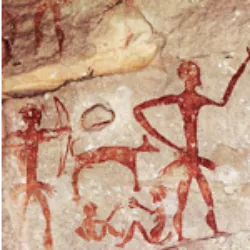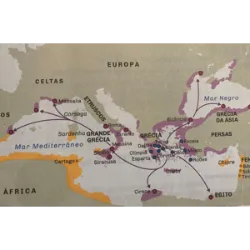Curiosities and Challenges about History
Do you like History?
Would you like to see more curiosities like these..
Transitional fossils are a series of finds that help in understanding the evolution of certain animals. For example,....
Amidst one of Scotland's darkest histories, the Black Dinner took place in 1440, during the reign of James II. The..
Amidst one of Scotland's darkest histories, the Black Dinner took place in 1440, during the reign of James II. The....
So.. How about a Challenge on the Best Quiz Platform in the World?
Each chapter is a learning opportunity
Get to know a little about everything and bet on your knowledge in incredible challenges and duels..
Join the betspot.zone community, accumulate bts (bets) and even compete for prizes..
Discover some interesting facts about History..
academic Quiz - academic Curiosities - academic Challenge - antiquity Quiz - antiquity Curiosities - antiquity Challenge - school Quiz - school Curiosities - school Challenge - - Frequently asked questions about History
The Revolution of April 25

The Revolution of April 25 , also known as the Carnation Revolution, was a historic event in Portugal, which took place on April 25, 1974, which overthrew the dictatorial regime of the Estado Novo, in force since 1933. Led by the Armed Forces Movement (MFA ), composed mainly of captains who had participated in the Colonial War, the movement enjoyed massive popular support. The military action resulted in few civilian casualties and led to the appointment of the National Salvation Board to govern the country. There followed a period of social and political unrest known as PREC (Revolutionary Process in Progress). On April 25, 1976, a new democratic Constitution came into force, marking the end of the authoritarian regime and the beginning of a democratic period in Portugal. The military coup was triggered by dissatisfaction with the colonial war, internal divisions within the regime and political repression.
celebrate in April 25
publicity
May 13th

May 13th marks the abolition of slavery in Brazil , in 1888, through the signing of the Lei Áurea by Princess Isabel. More than 700,000 slaves were freed, the result of decades of struggle by the abolitionist movement, civil society and the slaves themselves. However, abolition was not followed by effective measures to integrate black people into society, and racism persisted. The abolition process was gradual and faced resistance from slave-owning political elites, being marked by a series of abolitionist laws. Despite the difficulties, the abolition of slavery was a milestone in Brazilian history, highlighting the fight for equality and social justice.
celebrate in May 13
International Museum

International Museum Day is celebrated on May 18 and was established by the International Council of Museums to raise awareness of the role of museums in society. On this day, museums around the world offer special events, exhibitions and activities to engage the public and highlight the cultural and educational importance of museums. It is an opportunity for people to explore cultural diversity, learn about history, art and science, and appreciate global cultural heritage.
celebrate in May 18
The Farroupilha Revolution

The Farroupilha Revolution was an armed conflict that took place in southern Brazil between 1835 and 1845, led by Rio Grande do Sul farmers, the "farrapos", against the Brazilian imperial government. They sought greater regional autonomy, reduced taxes and an end to practices that harmed the local economy. The war was marked by bloody battles and brutality on both sides. The conflict came to an end with the signing of the "Peace of Ponche Verde" in 1845, which granted amnesty to the rebels and brought concessions from the imperial government. Gaúcho Day, or Farroupilha Revolution Day, is celebrated on September 20 , marking the beginning of the revolt in 1835. This date is important in Gaucho culture, being celebrated with parades, festivals and civic events throughout Rio Grande do Sul .
celebrate in September 20
publicity
October 9th

October 9th is European Rock Art Day. This date was established to raise awareness of the importance of rock art in European culture and history. Rock art refers to paintings and engravings made on rocks, dating back to prehistoric times. These works offer a valuable insight into ancient societies, their ways of life, beliefs and interactions with the environment. Rock art is considered a significant cultural heritage, not only for its aesthetic value, but also for its ability to tell the story of humanity. On this day, various organizations, museums and cultural institutions organize events, guided tours and educational activities to highlight the relevance of rock art.
celebrate in October 9
Traditions and Culture of the Valencian Community

Valencian Community Day is celebrated annually on October 9. This date is a regional festival that commemorates the entry of Jaume I, King of Aragon, into the city of Valencia in 1238, symbolizing the conquest of the city and the beginning of the process of repopulation and reconquest of the region. The festivities include parades, cultural events, sporting activities and concerts, reflecting the rich heritage and culture of the Valencian Community. One of the highlights of the celebrations is the traditional "ofrenda de flores" (flower offering) to the Virgin of the Forsaken, the city's patron saint, where residents bring flowers to create a large flower mantle in her image.
celebrate in October 9
October 12th

October 12th is the day of the Discovery of America , when the navigator Christopher Columbus, in the service of Spain, arrived on the American continent during his first expedition. Searching for a new route to the Indies, he ended up landing on the Caribbean islands, inaugurating an era of European exploration and colonization in the Americas. Columbus believed he had reached the Asian continent, but in fact he had discovered a new territory. This event had a profound impact on indigenous civilizations, which suffered from invasions, diseases and enslavement. The date is celebrated as the Discovery of America Day or Columbus Day in several countries, such as the United States, where it is marked by parades, but also by reflections on the impact of colonization. In Mexico and Spain, it is known as Hispanidad Day or Race Day, highlighting the Iberian cultural heritage.
celebrate in October 12
publicity
The Arrival in the Americas and Its Implications

October 12 , Columbus Day, commemorates the arrival of Christopher Columbus in the Americas on October 12, 1492, an important event in European colonization. Although the actual date is October 12, in the United States the holiday is celebrated on the second Monday in October, and has been a federal holiday since 1971. In New York City, the traditional parade has been held since 1929, with over 35,000 participants and over 1 million spectators, including floats and contingents. The holiday is also celebrated in countries such as Spain and Italy, honoring the Italian heritage. Officially established in 1937, Columbus Day is controversial due to the impact of colonization on indigenous populations. Some cities have replaced the date with Indigenous Peoples' Day. In Spanish-speaking countries, it is known as Hispanidad Day.
celebrate in October 12
Valmiki Jayanti

Valmiki Jayanti is a Hindu celebration dedicated to Valmiki, the author of the epic Ramayana and considered the first poet in Sanskrit literature. Celebrated on the Purnima (full moon) day of the month of Kartik, usually between October and November, the day honors his literary and spiritual contributions. Festivities include recitations of the Ramayana, prayers and worship in temples, as well as kirtans and lectures on Valmiki's teachings. The day also serves as an opportunity to reflect on the epic's values, such as virtue and duty, promoting the importance of literature and culture in the Hindu tradition.
Greece is located on the Balkan Peninsula and

Greece is located on the Balkan Peninsula and is washed by the Mediterranean Sea. Its civilization emerged from the 8th century BC, having its roots in mainland Greece, the islands of the Aegean Sea and the coasts of Asia Minor. It later expanded to the shores of the Mediterranean Sea, establishing colonies that contributed to economic and cultural links.
publicity
Egyptian civilization flourished in the northeast of the Afr

Egyptian civilization flourished in the northeast of the African continent along the banks of the Nile River, between the Arabian and Libyan deserts, from 3500 BC, lasting about 3000 years. Its development was driven by the fertility of the soil, enriched by the annual floods of the Nile. The Egyptians mastered engineering, building dikes and canals for irrigation during the dry season, as well as using the river as the main transportation and communication route for trade. Agriculture was the basis of the economy, cultivating wheat, barley, flax and other crops, while ranching, fishing and hunting. Crafts also prospered, including pottery, goldsmithing and metalworking. Agricultural surpluses boosted trade, with Egypt exporting wheat, pottery, and linen cloth, and importing raw materials such as wood, copper, and precious metals.
There are several ways to unravel the mysteries of the past

There are several ways to unravel the mysteries of the past. Historians, who are specialists who study and document the past, use a wide variety of traces left by ancient human societies, such as texts, photographs, paintings, buildings, sculptures, objects, clothing, oral reports, films, music and even fragments. of bones. They examine these sources to investigate information, formulate hypotheses and draw conclusions about events and aspects of the past. The set of traces left by ancient human societies, together with texts written by historians, encyclopedias and reconstructions of historical environments, is called historical sources. These sources are vital to understanding and interpreting past events.
Transitional fossils

Transitional fossils are a series of finds that help in understanding the evolution of certain animals. For example, bird fossils show how a group of dinosaurs gradually acquired features such as hollow bones and feathers. Turtles are an example of an animal whose origin is enigmatic, but which can be understood by transitional fossils. The ancestor of turtles had broad ribs but lacked the shell that is so characteristic of this species. Pappochelys already had the belly ribs, the gastralia, which would serve to form the plastron. Odontochelys already had a plastron, but with teeth, a feature that does not exist in modern turtles. The carapace, which is the part of the shell that is on the back of turtles, appeared in Proganochelys, 214 million years ago. These findings show how species slowly evolve to become the ones we know.
publicity
Amidst one of Scotland's darkest histories

Amidst one of Scotland's darkest histories, the Black Dinner took place in 1440, during the reign of James II. The monarch, concerned about the conspiracy that had claimed the life of his predecessor, James I, invited 16-year-old William Douglas and his younger brother to a feast. Midway through dinner, a large black bull's head was placed on the table, signaling the Douglases' death warrant. Even against the king's wishes, both were beheaded, and this tragedy came to be known as the Black Dinner.
Amidst one of Scotland's darkest histories

Amidst one of Scotland's darkest histories, the Black Dinner took place in 1440, during the reign of James II. The monarch, concerned about the conspiracy that had claimed the life of his predecessor, James I, invited 16-year-old William Douglas and his younger brother to a feast. Midway through dinner, a large black bull's head was placed on the table, signaling the Douglases' death warrant. Even against the king's wishes, both were beheaded, and this tragedy came to be known as the Black Dinner.
Classical antiquity (also called the classical era

Classical antiquity (also called the classical era, classical period, or classical age) is the period of cultural history between the 8th century BC and the 8th century BC. and V d.C. centered on the Mediterranean Sea, comprising the intertwined civilizations of ancient Greece and ancient Rome known as the Greco-Roman world. It is the period when Greek and Roman society flourished and exerted great influence across Europe, North Africa and western Asia. During this period, Greek-Roman mythology was born. The Greeks and Romans built several temples to their gods, places where they performed prayers and rituals, including animal sacrifices. The Greek gods were similar to the Roman gods. But some Roman gods have significant differences from the Greek gods. In Greek religion, names are in Greek. In Roman religion, names are in Latin.
publicity
Ancient Egypt is known for its pyramids, pharaohs

Ancient Egypt is known for its pyramids, pharaohs, wealth and, most importantly, mummification. When a nobleman or pharaoh died, his body was taken to the "Ibu", a place of purification, on the west bank of the Nile River. Priests were responsible for initiating the embalming process, washing the corpse with palm wine and river water. After that, the organs were removed, with the exception of the heart, which normally remained in place. The brain was removed through the nostrils. Many organs were kept in special containers, while the rest were thrown into the river. This funerary practice is still studied until today, because in addition to a procedure, it serves to better understand the culture of the Egyptian civilization.
Many ancient Indian warriors did not wear helmets to protect

Many ancient Indian warriors did not wear helmets to protect themselves during battle, which led to serious damage to the face, such as trauma to the ears and noses. To treat these injuries, Hindu doctors developed surgical techniques that do not differ much from modern ones. A common procedure was rhinoplasty, in which a piece of skin was cut from the patient's forehead and folded over to cover the nasal opening. Hollow tubes were also inserted to form the nostrils. Since the 5th century BC, there are records of such successful surgeries. Another extremely different but equally effective method was to use Bengali ants to sew up intestinal or abdominal wounds. The mandibles of these insects served as surgical staples, and were then removed when the patient's immune system was strong enough to absorb them.
Many believe that, at the moment of his death

Many believe that, at the moment of his death, Julius Caesar uttered the famous words: "Et tu, Brute?". However, the truth is that the controversial Roman dictator never said such a thing. The phrase was invented by William Shakespeare for his fictional character Caesar to say it. In fact, that wasn't Caesar's last line (it was "So fall, Caesar"). However, what did the historic Caesar say? Being someone from the upper class and with a formal education, it is likely that he communicated in Greek rather than Latin. His last breaths were, according to an ancient writer, "Kai su teknon", a phrase difficult to translate which, in the most accepted version, means "Even you, my son?". While it is possible that the words were directed at Brutus, as some rumors said he was Caesar's bastard son, others believe the phrase to be a threat to all those who conspired against him. In this case, the translation would be "You will be next, children".
publicity
Execution by crucifixion

Execution by crucifixion is an extreme punishment that originated in Persia around 500 BC and spread to many regions, including Rome. Some passages in the biblical Old Testament also suggest that the Jews of the time already applied punishment. Alexander the Great spread the act's popularity by storming the city of Tire and crucifying 2,000 of its adult male inhabitants in the 4th century BC. The Carthaginians were the most widely employed of crucifixion, and it is certainly from them that the Romans adopted the practice. However, the Romans did not usually crucify their own citizens, reserving the most extreme punishment for their worst criminals, such as Spartacus and his fellow rebels. In response to the uprising led by Spartacus, the Romans staged one of the largest mass crucifixions in history, killing approximately 6,000 rebellious slaves on crosses along the road from Rome to Capua in the year 71 BC.
During the reign of Henry II of England (1154-1189)

During the reign of Henry II of England (1154-1189), creativity was used to punish those found guilty. For example, an alleged horse thief was thrown into a tank of blessed water and, according to belief, if he floated, it would prove his guilt and consequently he would be executed. Otherwise, innocence would be proven.
Treatments for diseases like the Black Death

Treatments for diseases like the Black Death, which wiped out much of Europe's population in the 14th century, were wildly crazy and ineffective. Some of the recommendations were: sitting in the sewer to chase away the "bad air", which was responsible for this disease; consuming arsenic, which resulted in death; kill every dog and cat that could be found; rubbing the shaved hindquarters of a chicken into the wounds; and walk through cities whipping their backs.
publicity
More than two thousand years

More than two thousand years, the death of Alexander the Great remains unanswered. The most accepted version is that he fell ill after a night of drinking and died a few days later. According to Katherine Hall, a researcher at the University of Otago, the death of the Macedonian king may have been caused by Guillain Barré Syndrome. She explains that this condition causes muscle weakness, changes in the level of consciousness and, in some cases, weakening of the lungs. Thus, due to the limitations of medicine at the time, it is possible that Alexander was declared dead while he was still alive. The author believes he could have overheard the generals discussing the succession. Furthermore, he could have heard the arrival of the Egyptian embalmers and the completion of their work. Therefore, despite there being nothing supernatural in the story, the king's body showed no signs of decomposition even after seven days of his death, which contributed to the idea that he was divine.
Cleopatra's family had its origin in Macedonia

Cleopatra's family had its origin in Macedonia. After the death of Alexander the Great in 323 BC, Ptolemy I, one of his generals, took control of the government, founding the dynasty of the Ptolemies, which lasted for nearly three centuries. Despite not being ethnically Egyptian, Cleopatra adopted many of Egypt's customs, as well as learning the country's language. In 46 BC, she joined Julius Caesar and went to Rome, where she caused quite a stir with her presence. The queen considered herself a goddess on earth and erected a golden statue of herself in the temple of Venus Genetrix. When Julius Caesar was stabbed to death in the Senate in 44 BC, Cleopatra left the city, but her exotic hairstyle and pearl jewelry became fashionable among the Romans.
The Stone Age is marked by the manufacture of stone tools

The Stone Age is marked by the manufacture of stone tools, which differentiates human beings from other animals. This production began with the practice of hitting stones together to create sharp points. Around 700,000 years ago, Homo erectus learned to carve stones. This advance was only possible with the mastery of fire, which served to ward off animals, light up the camps at night and, mainly, for cooking. Cooked food was another decisive factor in increasing the human population and for the survival of human beings. The Stone Age can be divided into two parts: the Paleolithic, or Chipped Stone Age, and the Neolithic, or Polished Stone Age. The latter was marked by the beginning of a sedentary lifestyle, known as the Neolithic Revolution, which lasted approximately 10,000 years and brought agriculture and the domestication of animals.
publicity
Giza Necropolis, also called the Pyramids of Giza

Giza Necropolis, also called the Pyramids of Giza, is an archaeological site located on the Giza Plateau, outside Cairo, Egypt. This complex of ancient monuments includes the three pyramid complexes known as the Great Pyramids, the massive sculpture known as the Great Sphinx, several cemeteries, a working village and an industrial complex. The word pyramid does not come from the Egyptian language. It was formed from the Greek "pyra" (which means fire, light, symbol) and "midos" (which means measures).
Classical antiquity (also called the classical era

Classical antiquity (also called the classical era, classical period, or classical age) is the period of cultural history between the 8th century BC and the 8th century BC. and V d.C. centered on the Mediterranean Sea, comprising the intertwined civilizations of ancient Greece and ancient Rome known as the Greco-Roman world. It is the period when Greek and Roman society flourished and exerted great influence across Europe, North Africa and western Asia. During this period, Greek-Roman mythology was born. The Greeks and Romans built several temples to their gods, places where they performed prayers and rituals, including animal sacrifices. The Greek gods were similar to the Roman gods. But some Roman gods have significant differences from the Greek gods. In Greek religion, names are in Greek. In Roman religion, names are in Latin.
The Horoscope is an ancient practice

The Horoscope is an ancient practice, with records dating back to 7 BC. At that time, several ancient civilizations were already dedicated to observing the sky, believing that the stars could influence human life, especially the fate of newborns. This practice originated from the zodiac, which had its first record in 5 BC. The word is of Greek origin and means "circle of animals", referring to the celestial belt that marked the path of the Sun. Each constellation through which the star passed, symbolized a sign, phenomenon called ecliptic.
publicity
From ancient times

From ancient times, individual horoscopes and astrology have been used to understand human behavior. By analyzing a person's date and time of birth, astrologers can profile them and predict the future. Furthermore, at the beginning of the Christian Era, the seasons were associated with the different signs. Another influence was the observation of the temperament of people born in the same period, contributing to the characteristics associated with each sign.
Back
